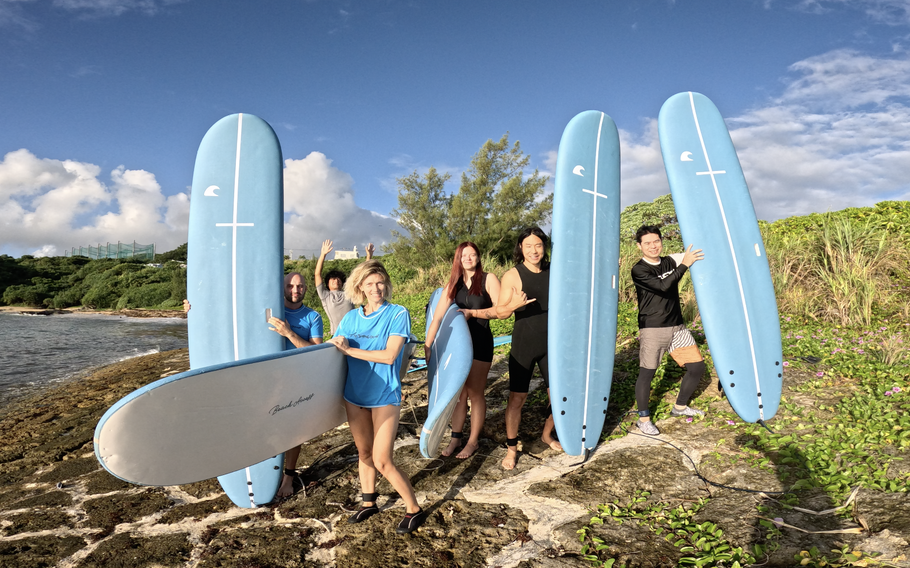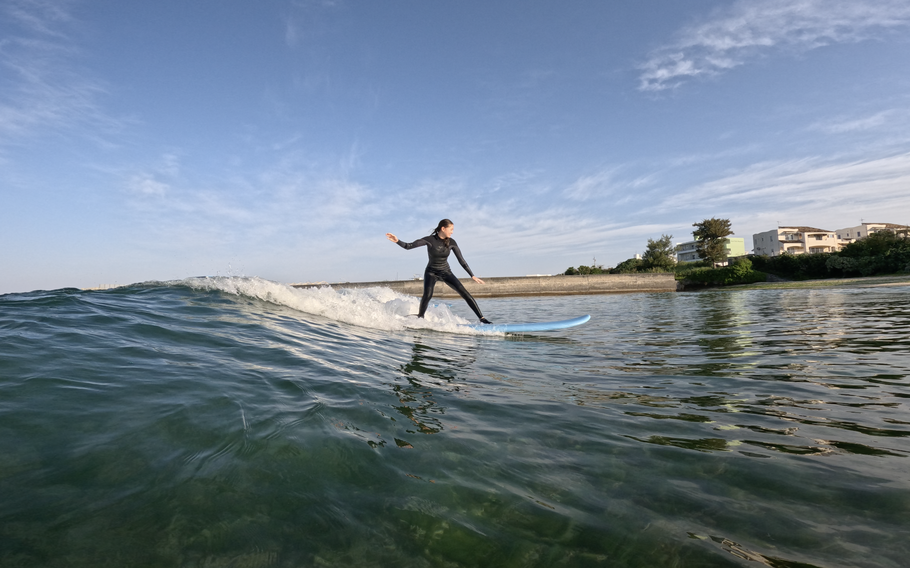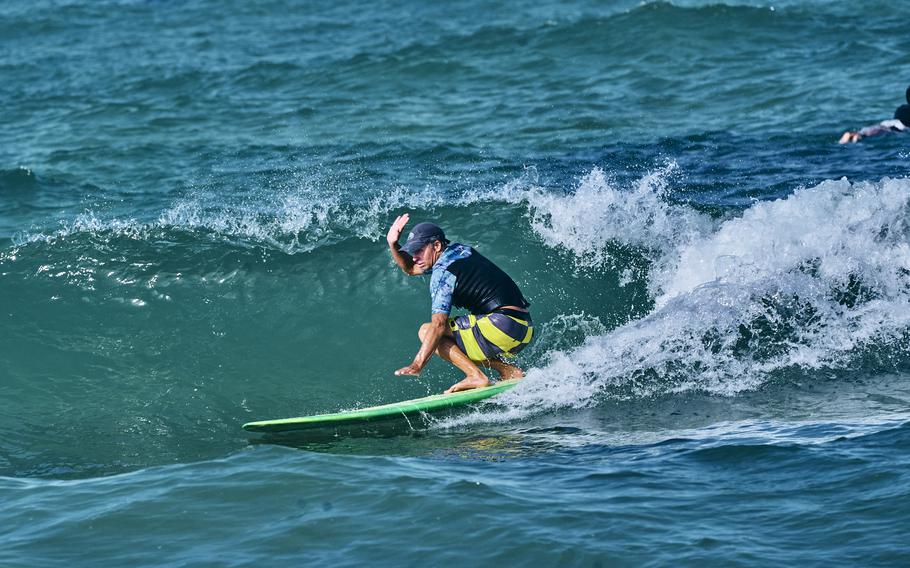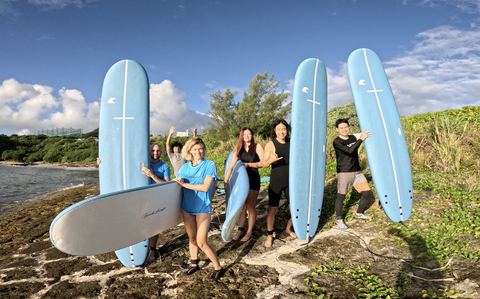
(Photo by Shoji Kudaka/Stripes Okinawa)
After catching some clips of “The Endless Summer,” a legendary surfing movie from the ‘60s, I was recently inspired to get back on a surfboard.
My last time hitting the waves was five years ago, so I’m not a surfer by any means. But the time was right, so I returned to Happy Surfing Okinawa in Yomitan for another lesson with pro surfer Danny Melhado.
I thought it could give me a lucky break in the “losing” battle to beat my 51 years of age.
The last time I surfed was during an afternoon session at a beach right outside Danny’s surf shop in Yomitan Village. This time, however, we headed to Higashi Onna Beach on the east coast, about a 30-minute drive away.
Four others, tourists from Europe and the U.S., joined the class and each of us carried our rental boards to the shore.
Unlike other beaches on the island, Higashi Onna Beach’s shore was covered with rocks and pebbles. So, we had to put on marine shoes (you can borrow a pair from the surf shop) to help protect our feet and navigate the rocky terrain.
We paddled out to where other surfers were lined up waiting for their turn to ride a wave. Based on how many surfers were out on the water, it was obvious it is a popular spot.
The waves were not huge like the ones you would see in surf movies, but they were quite high for a novice like me. Danny helped each of us with launching by cuing when to start paddling.
I was the last among the five to try the first ride, as I struggled paddling to the launch point. When I finally joined the instructor, however, he cued me right away, saying, “Go! Go!”

(Photo courtesy of Happy Surfing Okinawa)
Although I tried my best to stand on the board, it took me less than a second to lose balance. I was soon thrown into the water, with salty water filling my mouth and nostrils.
Grabbing onto the surfboard, I got back on. The first ride was a big challenge, but my way back to the launch point posed an even bigger problem for me. Since the waves were coming at me one after another, I was sent back toward the shore every time I advanced a little. Even when I managed to make some progress, some powerful waves came at me in succession, sending me back to where I began. At one point, a huge wave threw me at the rocky shore and pounding me against the rugged surface. Thanks to my long-sleeved shirt and the surfboard, I was not injured. I was shaken up a little, but the others in my group cheered me on to keep going.
I pulled myself together and gave it another shot. Though my paddling skills were not getting better, I was finally able to reach the launch point. I was exhausted when I reached Danny, but fortunately that meant I was too tired to tense up. I relaxed and stayed on the board a little longer than the last time. It was still shy of a second, but I could feel some confidence.
On my third try, finally, I succeeded in staying on board until the wave subdued. Folks watching me went “Yeah!” hooraying for the awkward beginner that I am.
After the successful ride, paddling back was once again a daunting challenge. But once I was back, I managed to have another decent ride. I tried six times in total during the one-hour session. Two were successful, the others lasted just one second or less. But I was happy to get the taste of surfing in a popular spot.
After the last ride, Jack, a visitor on the tour with me from San Francisco, gave me some useful advice on improving my surf skills.
“You need to do it every day to build skills. When you can’t go out, it’s time to work out and build muscles for paddling,” he said, pointing out the merit of learning from professionals like Danny. “It takes a long time to master the art of surfing. I’m still learning.”
Jack said he learned to surf as a kid growing up in California. For him, riding waves makes him feel like being a kid again.
Though I walked away a little beaten up and bruised, I was in a good mood after spending time on a board again. It was the perfect mix of exhaustion, muscle ache and delight I remember from playing soccer in the school yard decades ago. And at 51, it was nice to know that I could still be that adventurous kid.
Things to know
Q&A with pro surfer Danny Melhado

(Photo courtesy of Happy Surfing Okinawa)
Please tell us about yourself, how you started surfing and your passion for it.
I started surfing at the age of 10 in Florida. I competed from the age of 14 and became a member of the United States Surfing Team alongside world surfing champion Kelly Slater. I became an East Coast professional Champion and competed worldwide in the World Surf League. After retiring from traveling as a pro surfer, I began teaching surfing in Hawaii. I have been teaching surfing now for 15 years, 10 of which have been here at my surfing school in Okinawa, Happy Surfing Okinawa. I have 37 years surfing experience around the world.”
What is surfing like in Okinawa compared to other popular surfing locations?
Okinawa has some amazing world-class waves. It’s all reef breaks, which is not much different than Hawaii. The great thing about reef breaks is the wave is mechanical where it breaks in the same place every time and you have a channel of water to paddle back out so you’re not having to push through waves.
Now the hard facts about surfing in Okinawa: It’s very tidal (around 6 feet of water) so most places cannot surf at low tides. Okinawa is a wonderful place for small-wave surfing long boards and beginner surfing. We can find a place on island to suit fun, longboard, beginner surfing.
In the winter or summer typhoon season, we see bigger swells which tend to be more expert-only waves as they are generally fast, and hollow.
Do you have safety tips for surfing in Okinawa?
As far as surfing safe in Okinawa, you want someone to help teach you about tides, and each break is very different as well as each day is very different. You want to get to know the spots you frequent and have the best local knowledge you can get before just jumping into a new place. You can get so much out of a few guided tours, whether it is beginner school or getting introduced to a new spot.
Please tell us about your surf school. What should students expect from the program?
The lessons are set up a couple days prior via www.happysurfingokinawa.com and vary depending on the best location for your level and the day’s conditions. We meet at school at a set time according to the tide and the drive time it takes to get set up in the water. We limit lessons to a maximum of 5 people or less, so everyone gets great hands-on training and advice. We have a range of boards and will put you on what is best suited for your size and ability. We also have wetsuits and reef boots if needed.”
You have been to many places as a surfer. Could you give some advice on surf travel?
Surfing has become a popular worldwide sport and it’s wonderful to travel and experience all the waves, cultures and foods. There are lots of surf camps and schools around the world. I would always recommend you do your homework. Talk to people who have been there and what their experience was. If you’re going to take a surfing lesson, make sure you are being taught by a professional. Just because someone puts up an ad does not mean they are good teachers. Just like anything, there are a lot of bad apples out there just jumping on the wagon and you will get what you pay for. So do your research before your purchase.
What other advice do you have for those interested in surfing?
Surfing is a great way to stay fit, to get in touch with nature, and to give yourself time away from the stresses on land. You will be looking to improve your focus, balance, endurance (not muscles) and understanding of the ocean. Grace, finesse, style… smooth like butter. I look forward to sessions with you soon!”


AloJapan.com